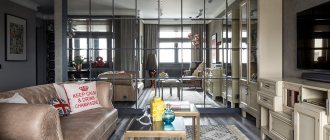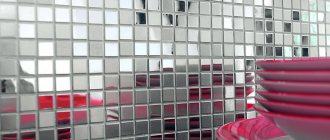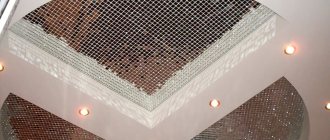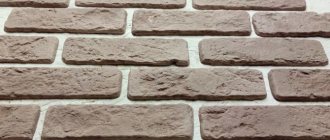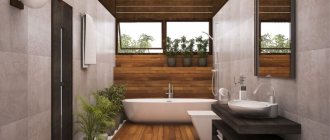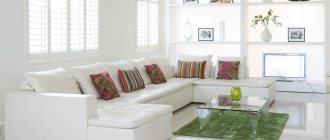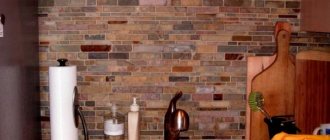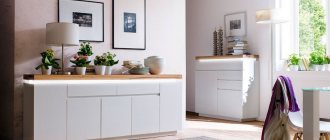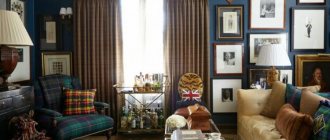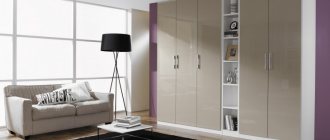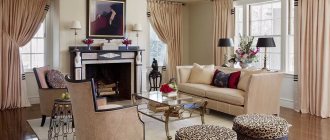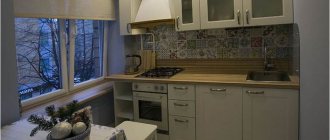Finishing material with a reflective effect scatters light well, which allows you to correct planning flaws. Mirror tiles in the interior of a room can positively transform a living room, bedroom or bathroom. In order for the component to fit harmoniously into the design, you need to choose the right cladding.
Bathroom material Source esign-homes.ru
Which mirror tile to choose? Review of materials
The choice of material is the key criterion to follow when purchasing mirror tiles. Essentially, you have two options: acrylic mirror tiles and glass mirror tiles .
Acrylic mirror tiles are made from a lightweight, unbreakable plastic called plexiglass or safety mirror . Unlike glass tiles, they guarantee complete safety. Even if the decoration falls from the wall onto a hard floor, it will remain intact.
Perspex also has the advantage of being easy to work with, and tiles made from it can take any shape. Laying tiles is fast and efficient. Plastic tiles are very lightweight, so simply stick them to the wall with double-sided tape.
At the same time, plexiglass is a soft material that is easily scratched and erased. Even cleaning the surface too vigorously can cause damage, including minor scratches and abrasions. Acrylic mirror tiles, especially in large sizes, distort reflections, so they are not a substitute for traditional glass mirrors.
All this makes them suitable only for decorative purposes and therefore for decorating small areas, such as the wall above the sofa in the living room or a door.
Mirror glass tiles have completely different parameters than plexiglass products. Although they can break or crack if subjected to a strong impact (such as from a heavy object), they do not cause any problems in everyday use.
Glass, as a material with high hardness, does not scratch or fade. Its smooth, non-porous surface makes it easy to remove any dirt while providing a clear and accurate reflection. Mirror tiles made from glass are renowned for their elegant appearance.
Of course, the quality of the product is of great importance. Cheap tiles made from glass waste or imported from Asia may have minor manufacturing defects (black spots and discoloration). In addition, they are susceptible to corrosion and are quite problematic to maintain. That's why it's so important to choose tiles from trusted manufacturers who specialize in glass products and use high-quality materials.
Optical illusion
Mirror is a unique material that designers eagerly use in their work. Still would! After all, a mirror allows you to achieve an elegant look, expand the space and even become the highlight of the interior. We are interested in optical illusion - let's find out what it is and how to achieve this effect.
To feel like you are in a fairy tale, where there is another door behind it, you can make a mirror in the form of an opening - it will seem that there is another room behind it, but in fact the living room is reflected in the mirror. Great trick for small spaces!
What to choose: beveled or polished mirror tiles?
Another decision that must be made when purchasing mirror tiles is the finishing of the edges. The tiles can be sanded or beveled depending on the desired effect. What is the difference between both processing methods?
Mirror tiles have straight edges. Thanks to this, the tiles are even on the entire surface and do not distort the image in any way. Thus, polished tiles are the best alternative to a regular mirror.
Mirror beveled tiles are more decorative. Their edges have an inclined shape, which gives the tiles a convex three-dimensional structure. Refractions on the surface of the tiles mean that light is reflected at different angles, creating dynamic, diffuse images. Because the reflection is distorted, beveled tiles cannot replace a mirror and should be considered primarily as decoration.
Shapes, sizes and colors of mirror tiles
The offer of mirror tiles, both glass and acrylic, is very rich. Tiles come in a variety of shapes, colors and sizes, so finding the perfect pattern shouldn't be too much of a challenge.
The most commonly chosen solution is silver mirror tiles , that is, the colors of a traditional mirror. In addition to being thin and suitable for any layout, they have the highest reflectivity of any tile type. Mirror tiles made of gold, copper, graphite or bronze are also available in the market. Vintage style lovers will love antique tiles (also known as antique tiles) that mimic the look of old and damaged crystal mirrors.
When it comes to tile shapes, manufacturers boldly follow trends. In addition to immortal squares and rectangles, rhombuses, hexagons and triangles appear mirror slabs . Kitchens and bathrooms are dominated by mosaics and mirrored bricks in a metallic color scheme.
Mirror tiles come in very different sizes. Manufacturers offer small mirror mosaics, small or medium-sized tiles (for example, 10 cm x 10 cm, 15 cm x 15 cm, 15 x 30), as well as large tiles that resemble ordinary mirrors (30 cm x 60 cm, 60 x 60 cm). In addition, it is possible to produce tiles to order - in any size specified by the customer.
Varieties
Faceted mirror tiles come in different sizes and shapes, with square tiles being the most popular. It is the easiest to install and easily combines with other finishing materials.
If you want to add a little variety to your space, lay the tiles in a diamond pattern, diagonally. Slightly less popular are rectangular mirror parts; they are laid according to the principle of laying bricks or like a prototype of a chessboard.
In addition to these 2 forms, there are also such forms of mirror panels as:
- Trapezoid.
- Triangle.
- Oval.
- Circle.
- Irregular polygon.
How to decorate the interior with mirror tiles?
Decorative mirror tiles are used in all types of interiors: in the living room, dining room, hallway, kitchen, bathroom or dressing room. As a rule, they decorate one wall or a small fragment of it. Here are some ideas on how to introduce mirrored tiles into your home decor.
In the kitchen and bathroom, tiles should be considered as an alternative to the popular ceramic tiles. A shiny glass panel can decorate the wall between the kitchen counter and cabinets, the corner of a sink, or the wall behind a freestanding bathtub.
Kitchen decoration
By using mirror tiles in decorating a kitchen, it will acquire a certain charm, high cost and elegance. This decor is most suitable for interiors in styles such as:
- classic;
- baroque;
- Empire style
The glare and play of light rays reflected in the mirror tiles will definitely lift your spirits and bring you joy for many years.
Despite the effect that reflective surfaces give, it is very important not to overdo it with the number of mirrors in one room.
Also, in order to avoid negative gloom and “overload” of the interior, it is not recommended to mount mirror panels opposite each other .
Another option for decorating a kitchen with mirror tiles is decorating a kitchen apron. This design solution is definitely very beautiful, but not at all practical. A mirrored kitchen apron will constantly be splashed with water, grease, and other contaminants; accordingly, it will need to be constantly cleaned.
Are mirror tiles suitable in the kitchen, bathroom or hallway?
Many people think that mirror tiles are too fragile and delicate to be used in the bathroom or exposed to dirt in the hallway. However, manufacturers guarantee that there are no contraindications for this. The glass surface of the tile is perfectly smooth, without pores, depressions or irregularities in which dirt can settle.
Thanks to this, it makes it easy to remove any stain and keep the wall perfectly clean. At the same time, the tiles are resistant to moisture, high temperatures and chemicals.
Of course, not every product can cope with difficult conditions. In the kitchen, bathroom or hallway, use high-quality glass mirror tiles. The tiles must have a reinforced backing and properly protected edges to prevent corrosion.
How to properly clean mirror tiles?
When installing mirror tiles in the kitchen or bathroom , you need to take care of frequent cleaning. Dirt does not stick or sink deeply into the glass surface, but it is clearly visible on it. How to effectively remove dirt from a tile surface?
Cleaning tiles does not require effort or the purchase of specialized products. For daily care, a universal glass and soft fabric cleaner is sufficient. Instead of applying the product directly to the dirty surface, spread it with a cloth and then wipe the tiles with a dry microfiber cloth or paper towel. Do not use strong substances, pastes or scouring powders on tiles, which may damage the smooth surface of the mirror.
Design
The types of reflective surfaces depend on the characteristics of the interior and the result that the designer wants to achieve. Instead of traditional mirrors, solutions with colored glass are often used. The effect is achieved by coloring the base of the finish.
Models with tinted glass Source pinterest.ru
The satin-finished surface looks expensive and luxurious. The creation technology involves a chemical etching method, which allows you to obtain a matte finish on the mirror. The designs can be uniform or with patterns (flowers, labyrinths). Models are used in the design:
- aprons;
- doors;
- furniture facades.
The aged mirror effect is a popular method that brings a retro touch to the design. Chemical treatment makes the reflective surface cloudy, cracks and defects appear. Deliberate destruction creates homeliness and a special vintage atmosphere in the interior.
Original finishing of the work area Source saligodesign.com
Sandblasting technology involves applying patterns to the outside or inside of glass. The mirror is covered with beautiful frost, a transparent image with the effect of removal or relief. The material is often used to decorate facades or inserted into special frames (baguettes).
Beautiful application of a pattern on an apron Source obzorkuhni.ru
The amalgam design technology looks unusual. The glass surface is partially destroyed on the machine, then colored pigments are applied. The finish acquires a velvety matte finish with mirror patterns. The raw materials are used in the design of aprons, walls and ceilings.
Faceted technology looks luxurious in the kitchen. Reflective surfaces complement the volumetric textures. Designers often use geometry (diamonds, squares). The beautiful reflection of glass edges brings mysterious notes to the room.
How to lay mirror tiles?
Mirror tiles can be mounted using mirror glue or special double-sided tapes. The first method is definitely more labor-intensive, but guarantees a long-lasting and accurate effect.
Before starting work, lay out the layout of the tiles and properly prepare the soil. The surface under the tiles must be clean, dry and level. In damp areas such as the kitchen or bathroom, you can additionally prime the wall with an insulating primer.
Choosing the right adhesive is of utmost importance when installing mirror tiles . The product must be intended for gluing mirrors or glass products. Before applying the product, make sure that the adhesive does not contain silicones or solvents, which could damage the underlying tile layer.
Mirror tiles can be laid with small gaps. In areas exposed to water and moisture, ensure that expansion joints are properly sealed. Instead of all-purpose grout or sanitary silicone, use specialty products such as mirror caulk or solvent-free silicone. Grouting of mirror tiles should be done by an experienced installer.
Mirror tiles are an excellent alternative to ceramic tiles, which are no longer as popular as they used to be. In addition to being a decoration, they protect the wall from dirt and optically enlarge the interior. Some of them successfully replace the mirror. If you dream of a spectacular apartment metamorphosis, be sure to check out this elegant material.
Use Cases
When decorating the ceiling with beveled mirror tiles, you can visually increase the height of the room. Along with this effect, the result is a visually inverted room, especially if the entire ceiling area is decorated with mirror slabs. Be sure to pay attention to what will be reflected in the mirror surface of the ceiling; in this case, there are special requirements for the floor, because you want the reflection to decorate the interior and not spoil it.
Experienced interior designers recommend making a mirror ceiling only in rooms with a small square footage.
When using beveled mirror elements in large rooms with high ceilings, you risk filling your interior not with beauty, but with emptiness, due to the visual expansion of an already large room.
